| Srl | Item |
| 1 |
ID:
152458
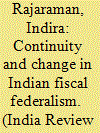

|
|
|
|
|
| Summary/Abstract |
This article focuses on whether the discontinuity in the structure of the Indian economy, which started with the economic reforms of 1991, triggered changes in federal fiscal arrangements. This examination is embedded in a larger overview of the basic fiscal structure, characterized by annual flows from the national government (the “Center”) to subnational states that have both statutory (guaranteed and formulaic) and non-statutory (discretionary) components. An unforeseen consequence of trade liberalization was the loss of trade tax revenue, which drove down tax collections at the Center both as a percent of GDP, and relative to states. Four major policy changes initiated after 1991 are attributable to post-reform concerns with efficiency in the fiscal structure. The final shift of indirect taxation to a fully value added configuration, with comprehensive coverage of goods and services, is scheduled for introduction by September 16, 2017.
|
|
|
|
|
|
|
|
|
|
|
|
|
|
|
|
| 2 |
ID:
152461
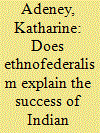

|
|
|
|
|
| Summary/Abstract |
Ethnofederalism has been contested as a solution for diverse societies as seen recently in Nepal (where federalism has been accepted, but the design and number of units remains heavily contested) and Myanmar (where ethnic minority demands for increasing federalization have had to take a back seat to the demands for increasing democracy). It remains a heavily contested subject in Sri Lanka. Concerns are expressed that ethnofederalism will increase pressures for secession and/or lead to increased violence through increasing a sense of separateness of the people living within that territory, providing resources for political entrepreneurs to mobilize groups against the center and will lead to the persecution of minorities within the ethnofederal units. India is an example of a federation that appears to demonstrate that ethnofederalism decreases rather than increases conflict through its successful reorganization of states along linguistic lines. However, a group-level analysis reveals a more diverse picture. India has simultaneously been both a success and a failure at conflict management.
|
|
|
|
|
|
|
|
|
|
|
|
|
|
|
|
| 3 |
ID:
152462
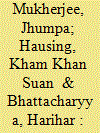

|
|
|
|
|
| Summary/Abstract |
This article critically examines territorial strategies adopted by the Indian state to accommodate territorially concentrated minority groups in two very recent cases: the formation of Telangana (2014) and the Bodoland Territorial Council (BTC) (2003). We situate both cases within the broader context of linguistic state reorganization in India since the 1950s. We argue that while the formation of states on the basis of linguistic principle was necessary given the long history of demand for linguistic states in India, it is, as Telangana and BTC clearly bear out, not sufficient to accommodate minorities. This is especially the case when, inter alia, language is: (1) appropriated by the dominant group within a state (or states) as a vehicle to perpetuate political majoritarianism, (2) supplemented by weak power-sharing arrangement, and (3) occasioned by longstanding popular perceptions of historical injustices and relative deprivation.
|
|
|
|
|
|
|
|
|
|
|
|
|
|
|
|
| 4 |
ID:
152460
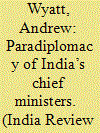

|
|
|
|
|
| Summary/Abstract |
Since the mid-1990s, state governments within India’s federal system have taken a greater interest in foreign relations. They have sought indirect influence by lobbying the central government to take account of their preferences and direct influence by seeking investment and making links with international organizations and other national and subnational governments. This article considers how chief ministers engage in parallel diplomacy noting how they draw on regional cultural resources and make connections with a regionally defined diaspora. The article finds that some chief ministers have embraced the role of “chief diplomat,” while others take a more discreet approach to international activity. Comparing the cases of Andhra Pradesh, Kerala, and Tamil Nadu reveals the political logic for expanding, de-emphasizing, or avoiding international engagement.
|
|
|
|
|
|
|
|
|
|
|
|
|
|
|
|
| 5 |
ID:
152457


|
|
|
|
|
| Summary/Abstract |
This article critically assesses the impact of the Planning Commission on center-state relations in India. It argues that the Planning Commission had a centralizing effect due to its role in overseeing five year and annual planning, its contribution to designing and overseeing Centrally Sponsored Schemes (CSS), and its involvement in discretionary grant-making. Central policy priorities and inter-state disagreements prevented the Planning Commission from acquiring the role of a shared rule institution, capable of offsetting the centralizing implications of the aforementioned policies. The article then speculates on what prompted the recent replacement of the Planning Commission with the NITI Aayog and what this may mean for shared rule and the nature of collaborative federalism in India more in general.
|
|
|
|
|
|
|
|
|
|
|
|
|
|
|
|
| 6 |
ID:
152456
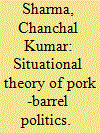

|
|
|
|
|
| Summary/Abstract |
Despite the extensive literature on distributive politics, there is still is a lack of a theory of how political and fiscal institutions interact to shape the pork barreling ability of national leaders in a federal parliamentary democracy. This article examines how the party system types (dominant party versus coalition system) and particular attributes of discretionary grants (providing credit claiming opportunity or facilitating side payments) influence opportunities for pork-barrel politics. This article proposes a situational theory of distributive politics that states that incentives for exclusive targeting of affiliated states in one-party dominant systems drive national ruling parties toward particularism while the shrinking opportunity to indulge in such a policy in multiparty coalition systems creates a universalization effect. The disaggregated analysis of discretionary grants using Indian data for 14 states for the one-party dominant period (1972–89) and the coalition era (1996–2012) confirms the theoretical expectations. Additionally, the exercise brings to the fore the fact that the shift from particularism to universalism occurs for schematic grants that provide credit claiming opportunity. The ad hoc grants that are like side payments remain subject to particularism.
|
|
|
|
|
|
|
|
|
|
|
|
|
|
|
|
| 7 |
ID:
152459


|
|
|
|
|
| Summary/Abstract |
This article examines the role of India’s states in shaping the implementation and framing of social policy within India’s federal system. Since the 2000s, the central government has overseen a substantial expansion of social welfare policies partly through a new push toward rights-based social provision. Yet, it is India’s states that are both responsible for an increasing proportion of total public expenditure on social welfare provision as well as determining the nature and effectiveness of that provision across space. Drawing on a comparative research program across pairs of Indian states, three critical factors explaining how state-level political environments shape social policy are identified: the role of policy legacies in shaping policy frames; the role of social coalitions underpinning political party competition; and the role of political leaders in strengthening state capacity to achieve program goals.
|
|
|
|
|
|
|
|
|
|
|
|
|
|
|
|